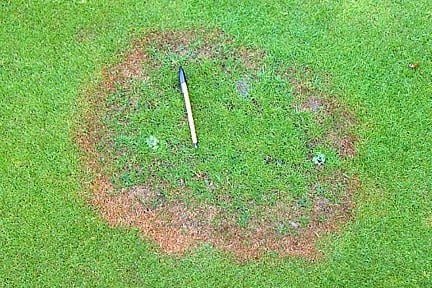
Quick facts
Common name - Take-all (formerly known as Ophiobolus patch)
Scientific name - Gaeumannomyces graminis
Plants affected - Agrostis spp. (fine turf bentgrasses)
Main symptoms - Brown patches in lawns
Caused by - Fungus
Timing - Midsummer to autumn
What is take-all patch?
Take-all patch is caused by a fungus, Gaeumannomyces graminis, which is found commonly in soil. The disease is very damaging to bentgrasses (Agrostis species). Most turf initially contains a fairly low percentage of bentgrass (usually browntop bent, Agrostis tenuis), but the proportions of the different grass species can change with time. Expect to see damage from mid-summer until autumn.
The same fungus also causes a serious root and foot rot disease of cereal crops.
Symptoms
These symptoms are seen most often in summer, especially if the lawn comes under drought stress.
You may see the following symptoms:
- Patches or rings of affected grass with reddish leaves, turning brown as the grass is killed
- Patches can vary in size from 1-2cm (½-1in) to 1m (3¼ft) or more in diameter. The centre of the patch often becomes colonised by grasses with more resistance to the disease, such as annual meadow grass (Poa annua), or by broadleaved weeds
- The roots of the grasses blacken and decay, and it is often easy to peel back the affected turf due to the lack of roots
Control
Non-chemical control
Take-all patch can be difficult to eradicate once it has developed. Over time, there may be a build-up within the soil of micro-organisms antagonistic to the take-all fungus, resulting in lower disease levels (a phenomenon known as ‘take-all decline’). In practice, however, it may be better (and certainly quicker) to over-seed affected areas with ryegrass or fescues.
Prevention
Scarifying the turf with a lawn rake or electric scarifier in autumn will remove thatch and moss and increase aeration. Poor drainage and compacted areas can be alleviated by forking or by the use of a solid-tine or hollow-tine aerator. Ensure that the lawn is growing strongly by applying adequate (but not excessive) fertiliser. The pH of alkaline soils can be reduced by using acidifying fertilisers such as ammonium sulphate.
Chemical control
There are no fungicides available to home gardeners for the control of take-all. Some lawn maintenance companies offer treatment with a professional fungicide, but there is strict legislation controlling the application of professional products to domestic gardens. You will therefore need to satisfy yourself that the company is operating within the law.
Biology
The development of take-all patch is favoured by alkaline soil conditions. A soil may be naturally alkaline, but the pH can also be increased by liming, top dressing with a material with high lime content or even by irrigating with hard (alkaline) water.
Poor drainage can lead to rapid spread of the disease, but soils with a high sand content are also very prone to attack. Excessive thatch can also lead to problems by increasing moisture levels.








